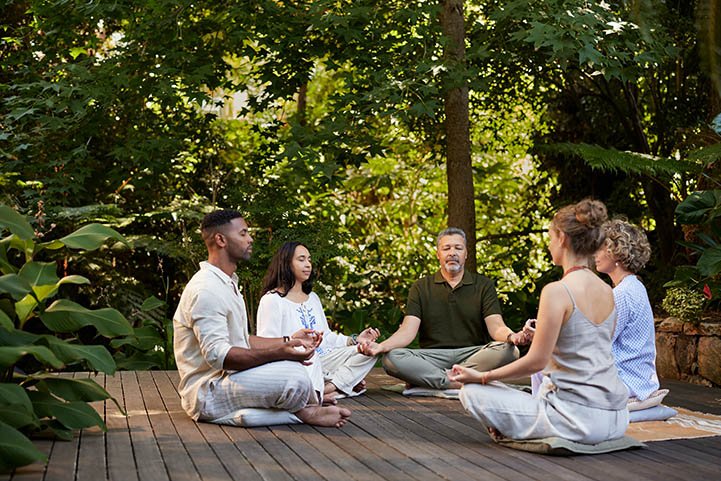
Benefits
Learn how emotional regulation and SKY Breath Meditation help you manage stress, cultivate resilience, and live with greater calm and awareness.
Emotional regulation refers to the ability to manage and respond to emotional experiences in adaptive ways — a vital part of maintaining overall well-being. Managing your own emotions is central to emotional regulation, as it helps you navigate challenges and maintain balance.
It is not about eliminating feelings, but about moderating or controlling emotions—understanding your emotional landscape, recognizing how feelings arise, and learning how to respond rather than react.
Emotional regulation allows you to pause before reacting, to interpret situations more clearly, and to make decisions guided by awareness rather than impulse. It supports healthier relationships, improved communication, and greater personal satisfaction because it gives you mastery over your inner state.
Common techniques such as cognitive reappraisal — reinterpreting an event to shift its emotional meaning — and mindfulness — staying fully present without judgment — are well-known for improving emotional control. When these skills are underdeveloped, emotional instability can manifest as anxiety, depression, or chronic stress, all of which can compromise both mental and physical health. Effective emotional regulation is also a key factor in preventing or managing mental illness by promoting resilience and emotional stability.
Learning to regulate emotions is, therefore, not just a psychological exercise but a key to resilience, mental clarity, and lasting happiness.
Emotional regulation skills help you navigate life’s highs and lows with steadiness and clarity.
These skills allow you to acknowledge difficult emotions without being overwhelmed by them and to use emotions as information rather than as obstacles.
Developing emotional regulation involves several essential abilities, which are core emotion regulation abilities crucial for emotional well-being and social functioning:
These skills can be cultivated through consistent self-reflection, therapy, mindfulness training, or contemplative practices.
When you strengthen emotional awareness, you expand your capacity for compassion — both toward yourself and others.
Ultimately, emotional regulation skills make it possible to remain centered even when life feels unpredictable.

When emotional regulation is lacking, dysregulated emotions often take over.
You may feel that your emotions are controlling you rather than the other way around.
This can lead to impulsive behavior, misunderstandings, and strained relationships.
Poor emotional regulation is associated with increased risk of anxiety, depression, and mood disorders such as borderline personality disorder.
Affective disorders, including depression and anxiety, are also commonly linked to poor emotion regulation.
It may also lead to physical symptoms like muscle tension, sleep disturbance, fatigue, or headaches, since the body and mind are deeply connected.
Maladaptive strategies such as suppression, avoidance, or emotional numbing may provide short-term relief but often amplify distress and negatively impact mental health in the long run.
When emotions are repeatedly pushed aside instead of processed, they can build up and erupt in unhelpful ways — through irritability, burnout, or emotional exhaustion.
Recognizing the costs of emotional dysregulation is the first step toward building healthier emotional habits. With awareness, support, and structured practices, it is possible to restore emotional balance and strengthen resilience.
Emotion dysregulation occurs when it becomes difficult to manage and modulate emotional responses in everyday life. Instead of being able to down-regulate negative emotions like anxiety, anger, or frustration, individuals may find themselves overwhelmed by intense emotional reactions that seem out of proportion to the situation. This heightened emotional arousal can lead to mood swings, impulsive behavior, and a sense of being at the mercy of one’s emotions.
Emotion dysregulation is often at the root of many mental health challenges, including depression, anxiety disorders, and borderline personality disorder. When negative emotions are not effectively regulated, they can disrupt daily functioning, strain relationships, and contribute to ongoing psychological distress.
Recognizing emotional triggers is a crucial first step in addressing emotional dysregulation. By identifying the situations, thoughts, or memories that spark strong emotional responses, you can begin to anticipate and prepare for them. Self-reflection and cognitive reappraisal are powerful emotion regulation strategies that help you reinterpret negative experiences and regain a sense of control. Developing healthy coping strategies—such as mindful breathing, journaling, or seeking support—can further support effective emotion regulation and reduce the risk of being overwhelmed by difficult emotions.
With practice and patience, it is possible to strengthen your ability to regulate emotions, respond thoughtfully rather than react impulsively, and build greater resilience in the face of life’s challenges.

There are many scientifically supported strategies to help regulate emotion and build inner strength. These tools can be practiced in daily life and adapted to individual preferences and situations.
Cognitive reappraisal is one of the most potent techniques — reframing the meaning of an event to change how it affects you emotionally. For example, instead of seeing a challenge as a threat, you might view it as an opportunity to learn or grow. This subtle shift in perspective transforms the emotional experience and reduces stress.
Mindfulness is another cornerstone strategy. It involves noticing your thoughts and emotions as they arise without judgment. This awareness creates space between stimulus and response, allowing for calm decision-making instead of automatic reaction. In contrast, maladaptive strategies like suppression can deplete cognitive resources, which impairs memory, decision-making, and overall functioning.
Response modulation — intentionally adjusting how you express emotion — can include relaxation practices such as deep breathing, stretching, or journaling. Problem-solving strategies, meanwhile, help you address the root causes of distress rather than merely treating the symptoms.
By combining these techniques, you can down-regulate negative emotions, increase positive ones, and cultivate greater emotional control. Regular practice brings lasting benefits to mental health, relationships, and overall well-being. A recent meta-analytic review supports the effectiveness of these emotion regulation strategies across diverse populations.
Negative emotions are part of being human.
Anger, fear, grief, negative emotion, and anxiety arise as natural responses to life’s challenges.
The goal of emotional regulation is not to eliminate these emotions but to transform your relationship with them.
When negative emotions arise, start by acknowledging them rather than resisting them.
Notice where they live in your body — perhaps tension in the shoulders or heaviness in the chest — and breathe into that space.
Labeling emotions without judgment helps reduce their intensity and allows you to manage your emotional response better.
Techniques such as mindful breathing, grounding exercises, and cognitive reappraisal are effective in soothing emotional arousal. Taking a few slow, deep breaths activates the parasympathetic nervous system, signaling safety to the body and mind. These practices help you downregulate negative emotion, making it easier to respond thoughtfully rather than react impulsively.
Remember that emotions are like waves — temporary and dynamic.
By practicing acceptance and allowing emotions to flow, you develop greater self-trust and inner stability. Over time, this mindful approach helps transform negative experiences into opportunities for growth and healing.

Emotional triggers can be events, people, or memories that evoke strong emotional reactions. They may stem from past experiences, stress, exhaustion, or unresolved conflicts. Recognizing your triggers gives you a powerful advantage — awareness precedes transformation. For individuals with greater emotional sensitivity, certain triggers can feel especially intense and overwhelming, making it even more important to identify and manage them effectively.
When a trigger arises, notice it without judgment. Take a deep breath before responding and give yourself permission to pause. This moment of awareness creates the space needed to choose a conscious reaction instead of falling into automatic patterns.
Mindfulness, journaling, and breathwork are powerful tools for reducing the impact of triggers. These practices calm the nervous system, helping the body recover from emotional shock more quickly.
With consistent practice, you can begin to anticipate and defuse triggers before they escalate, maintaining emotional control and preserving harmony in relationships. Recent behaviour research supports the effectiveness of mindfulness and journaling in helping individuals manage emotional triggers and improve overall emotional regulation.
Emotional regulation is not only about managing stress but also about nurturing positive emotions that support joy, love, and gratitude. Exposure to positive stimuli, such as rewarding experiences or positive feedback, can enhance positive emotions and build resilience.
Positive emotions expand your sense of possibility, build resilience, and strengthen your ability to cope with challenges.
Cultivating positivity begins with simple, intentional actions such as:
These techniques shift brain chemistry toward optimism and connection, making emotional balance more sustainable. The more you consciously cultivate positivity, the more resilient your emotional system becomes in times of stress.

Healthy emotion regulation is sustained by the choices you make every day. Self-regulation is a foundational skill for maintaining emotional balance and mental health.
Lifestyle, social connection, and spiritual practice all influence emotional balance.
When you care for your body and mind together, emotional harmony becomes a natural state rather than a constant effort. Research in psychological inquiry supports the effectiveness of these strategies.
Regular exercise helps release built-up tension and stabilize mood by increasing endorphin levels.
Balanced nutrition supports the production of serotonin and dopamine, the neurotransmitters that regulate mood and motivation.
Adequate sleep restores emotional circuits in the brain, helping you process and integrate experiences.
These foundational practices support emotional regulation across different age groups, as children, adolescents, and adults each benefit from tailored approaches that address their unique neurodevelopmental needs.
Strong social support — whether through friendships, family, or community groups — provides safety and connection during emotional turbulence. Recognizing and naming secondary emotions within these supportive relationships can help process complex feelings and promote emotional clarity.
Among the most effective methods for maintaining emotional well-being are breathwork and meditation. These practices are highly effective for modulating emotions, as they directly influence the nervous system, improving emotional regulation from the inside out.
SKY Breath Meditation, taught in the Art of Living Part 1 Course, is a scientifically researched technique that uses specific rhythmic breathing patterns to release stress and calm the mind. By activating the parasympathetic nervous system, SKY reduces cortisol levels, enhances emotional stability, and increases serotonin — the “feel-good” hormone. Practitioners often describe feeling lighter, calmer, and more connected after each session.
Daily breathwork practice builds emotional resilience, while meditation cultivates awareness and self-acceptance. These practices can also help process and release painful feelings by providing a safe space to acknowledge and work through difficult emotions. Together, they form a holistic foundation for mental health — balancing energy, emotions, and awareness.
When combined with exercise, good sleep, and mindful nutrition, these practices help maintain emotional equilibrium, enhance focus, and promote long-term well-being.
Emotional regulation is a skill that deepens over time. Regulating emotion regulation is an ongoing process that requires continual adjustment of emotional strategies as life circumstances change.
It requires patience, compassion, and consistent practice. Every moment of awareness, every deep breath, and every act of mindfulness contribute to the gradual strengthening of emotional intelligence.
Through techniques like mindful reflection, healthy lifestyle habits, and SKY Breath Meditation, anyone can transform reactivity into resilience and confusion into clarity. Emotional regulation does not mean becoming emotionless — it means becoming emotionally wise.
Role play can also be used as a practical tool to strengthen emotional regulation skills by allowing individuals to explore and practice different emotional responses in a safe environment.

True emotional regulation is about harmonizing your inner world — understanding what you feel, why you feel it, and how to respond with awareness and compassion. This process is supported by key brain regions such as the prefrontal cortex and anterior cingulate cortex, which play crucial roles in managing and regulating emotional responses.
By integrating breathwork, mindfulness, and healthy daily habits, you can cultivate lasting peace, deeper relationships, and a greater sense of control over your life.
Practices such as SKY Breath Meditation empower you to experience emotions fully yet remain anchored in calm and clarity. When emotions are guided by awareness rather than impulse, you unlock your greatest source of freedom — the ability to choose your state of mind, no matter what life brings.
Experience the power of emotional balance through SKY Breath Meditation with the Art of Living Part 1 Course. Learn proven techniques to release stress, regulate emotions, and cultivate lasting happiness from within.












